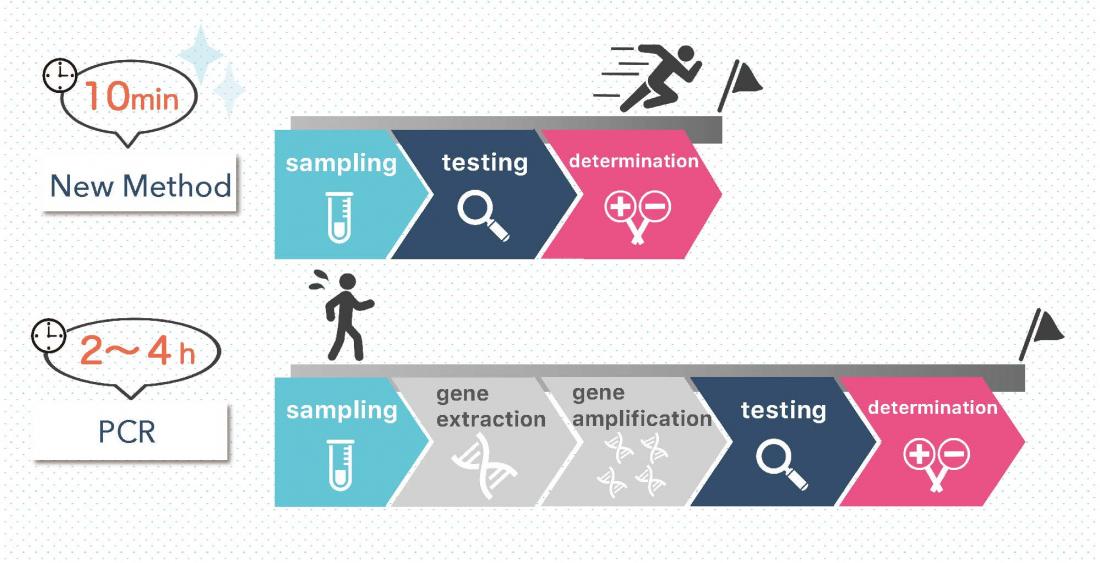Fig. Rapid Testing for Mutant SARS-CoV-2 Using AI Nanopores
Research out of Osaka University unveils a novel technique to detect different coronavirus variants quickly, including fast-spreading strains present in human saliva
Osaka, Japan – A rapid, accurate way of testing for COVID-19 infection would be a big step in overcoming the virus’ hold over our society. Now, in an article published in Lab on a Chip, Japanese researchers have developed a promising solution: a novel platform that couples nanopore technology with artificial intelligence.
What is a nanopore? A nanopore is a miniscule hole in a thin substrate, often a silicon wafer. A nanopore might range from several nanometers to several hundred nanometers in diameter — a scale small enough to work with SARS-CoV-2, the virus that causes COVID-19.
Kaoru Murakami, the study’s lead author, explains: “Our technology involves looking at changes in the electrical current as different materials are passed through tiny nanopores. With the use of artificial intelligence, we can understand the structure, volume, and surface charge of different materials, including viruses.”
SARS-CoV-2 is typical of many other RNA viruses in that it constantly mutates, thereby changing the properties of the virus – including infection rates and symptoms. One infamous mutation of the virus, the Omicron variant, was first identified in November 2021 and is known for its ability to spread quickly. One of the greatest challenges for COVID-19 testing so far has been accurately determining the presence or absence of newly mutated variants in a sample.
Thus, the researchers first sought to demonstrate that their platform could detect differences between six different variants of SARS-CoV-2. Next, they investigated whether their platform could identify SARS-CoV-2 strains in 241 saliva samples, collected from 132 people infected with SARS-CoV-2 and 109 uninfected people.
Not only was the platform able to distinguish between SARS-CoV-2 variants, but it was also able to determine the presence of the Omicron variant 100% of the time.
The researchers hypothesize that their AI-driven platform is detecting differences in the so-called spike proteins (also called S-proteins) that coat the surface of coronaviruses. These proteins, which tend to mutate very quickly, bind to host cell receptors and play a crucial role in penetrating host cells.
Until now, the gold standard for SARS-CoV-2 detection has been a method called RT-PCR (the reverse transcription-polymerase chain reaction test).
“Like RT-PCR, our AI-nanopore platform can detect coronavirus with high sensitivity and specificity. However, a major advantage of our nanopore system is that it is much less expensive and has the potential to measure a larger number of samples in a given period of time,” explains Masaaki Murakami, senior author.
The benefits of this system are not specific to SARS-CoV-2; other RNA viruses also tend to have high mutation rates, and so this platform could be used to detect viruses such as influenza. The new platform could even be rapidly adapted to test for the next newly emerged infectious disease.
###
Thearticle,“High-Precision Rapid Testing of Omicron SARS-CoV-2 Variants in Clinical Samples Using AI-Nanopore,” was published in Lab on a Chip at DOI: https://doi.org/10.1039/D3LC00572K
About Osaka University
Osaka University was founded in 1931 as one of the seven imperial universities of Japan and is now one of Japan's leading comprehensive universities with a broad disciplinary spectrum. This strength is coupled with a singular drive for innovation that extends throughout the scientific process, from fundamental research to the creation of applied technology with positive economic impacts. Its commitment to innovation has been recognized in Japan and around the world, being named Japan's most innovative university in 2015 (Reuters 2015 Top 100) and one of the most innovative institutions in the world in 2017 (Innovative Universities and the Nature Index Innovation 2017). Now, Osaka University is leveraging its role as a Designated National University Corporation selected by the Ministry of Education, Culture, Sports, Science and Technology to contribute to innovation for human welfare, sustainable development of society, and social transformation.
Website: https://resou.osaka-u.ac.jp/en
PIO Contact
Name: Saori Obayashi
Organization: Osaka University
Organization URL: https://resou.osaka-u.ac.jp/en
Organization Twitter Handle: @osaka_univ_e
Email: [email protected]
About Hokkaido University
Founded in 1876 as Sapporo Agricultural College, Hokkaido University is one of the oldest, largest, and most prestigious universities in Japan. The university attracts prospective students from all around the globe with the diverse degree programs offered and the year-round scenic beauty. The campuses are located in the cities of Sapporo and Hakodate of Hokkaido, and 21 facilities are spread throughout Hokkaido and mainland Japan.
Website: https://www.global.hokudai.ac.jp/
PIO Contact
Name: Sohail Keegan Pinto
Organization: Hokkaido University
Organization URL: https://www.global.hokudai.ac.jp/
Organization Twitter Handle: @HokkaidoUni
Office Phone: +81-11-706-2186
Cell Phone:
Email: [email protected]



